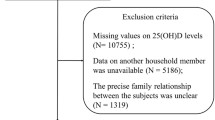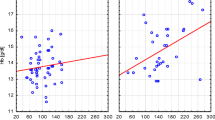Abstract
Background
Despite the high transferrin saturation (TS) level in Koreans, the p.Cys282Tyr and p.His63Asp mutations are markedly less frequent than in Caucasians. We aimed to determine TS levels and their familial tendencies in a Korean population using nationwide data from the Fifth Korea National Health and Nutrition Examination Survey (KNHANES V-1 2010).
Methods
A total of 4904 subjects without a history of hepatitis B and C virus infection, or liver cirrhosis, and who were negative for anemia and hepatitis B antigen were enrolled. A familial tendency analysis was performed in 260 families. Parents were grouped into four quartiles based on their TS levels. Offspring were categorized according to the mean parental TS four quartile scores (1.0, 1.5, 2.0, 2.5, 3.0, 3.5, and 4.0). A familial tendency was evaluated by comparing the mean TS of offspring in seven parental groups.
Results
The mean TS was 39.3 ± 15.6 % for Korean males and 33.2 ± 12.9 % for Korean females, and both were significantly higher than those of Caucasians reported in the HEIRS study (30.6 ± 11.0 % for male, 25.6 ± 10.6 % for female, P < 0.001). The 260 families showed statistically significant familial tendencies of TS values (P < 0.001). The mean TS of offspring in parental group 1.0, 1.5, 2.0, and 2.5 showed a lower value than that in higher group 3.0, 3.5, and 4.0. In contrast, there were no significant differences in age, daily dietary iron intake, and AST or ALT value among seven groups.
Conclusions
These findings suggest unidentified genetic variations on high TS in Koreans beyond the p.Cys282Tyr and p.His63Asp mutations commonly identified in Caucasians.


Similar content being viewed by others
References
Nadakkavukaran IM, Gan EK, Olynyk JK. Screening for hereditary haemochromatosis. Pathology. 2012;44:148–152.
El-Serag HB, Inadomi JM, Kowdley KV. Screening for hereditary hemochromatosis in siblings and children of affected patients. A cost-effectiveness analysis. Ann Intern Med. 2000;132:261–269.
Powell LW. Chapter 357. Hemochromatosis. In: Longo DL, Fauci AS, Kasper DL, et al., eds. Harrison’s Principles of Internal Medicine, 18e. New York: McGraw-Hill; 2012.
Phatak PD, Bonkovsky HL, Kowdley KV. Hereditary hemochromatosis: time for targeted screening. Ann Intern Med. 2008;149:270–272.
Pietrangelo A. Hereditary hemochromatosis—a new look at an old disease. N Engl J Med. 2004;350:2383–2397.
Adams PC, Reboussin DM, Barton JC, et al. Hemochromatosis and iron-overload screening in a racially diverse population. N Engl J Med. 2005;352:1769–1778.
Choi SJ, Min WK, Chun S, et al. Frequencies of C282Y and H63D mutations and transferrin saturation indices in the Korean population. Clin Chem Lab Med. 2002;40:689–692.
Lee SH, Kim JW, Shin SH, et al. HFE gene mutations, serum ferritin level, transferrin saturation, and their clinical correlates in a Korean population. Dig Dis Sci. 2009;54:879–886.
Harris EL, McLaren CE, Reboussin DM, et al. Serum ferritin and transferrin saturation in Asians and Pacific Islanders. Arch Intern Med. 2007;167:722–726.
Jackson HA, Carter K, Darke C, et al. HFE mutations, iron deficiency and overload in 10,500 blood donors. Br J Haematol. 2001;114:474–484.
McPherson R, Pincus M. Chapter 3. Preanalysis. In: Sanford K, McPherson R, eds. Henry’s Clinical Diagnosis and Management by Laboratory Methods. 22nd ed. Philadelphia: Elsevier; 2001.
Korean Ministry of Health and Welfare, Korea Centers for Disease Control and Prevention. The Korea National Health and Nutrition Examination Survey 2010 (KNHANES V-1). https://knhanes.cdc.go.kr. Accessed 20 June 2014.
Pedersen P, Milman N. Extrinsic factors modifying expressivity of the HFE variant C282Y, H63D, S65C phenotypes in 1,294 Danish men. Ann Hematol. 2009;88:957–965.
Bothwell TH, Seftel H, Jacobs P, et al. Iron overload in bantu subjects; studies on the availability of iron in bantu beer. Am J Clin Nutr.. 1964;14:47–51.
Hayashi H, Wakusawa S, Motonishi S, et al. Genetic background of primary iron overload syndromes in Japan. Intern Med. 2006;45:1107–1111.
Lok CY, Merryweather-Clarke AT, Viprakasit V, et al. Iron overload in the Asian community. Blood. 2009;114:20–25.
Santos PC, Cançado RD, Pereira AC, et al. Hereditary hemochromatosis: mutations in genes involved in iron homeostasis in Brazilian patients. Blood Cells Mol Dis. 2011;15:302–307.
Santos PC, Cançado RD, Terada CT, et al. HFE gene mutations and iron status of Brazilian blood donors. Braz J Med Biol Res. 2010;43:107–114.
Conflict of interest
None.
Author information
Authors and Affiliations
Corresponding author
Rights and permissions
About this article
Cite this article
Oh, SH., Jeong, TD., Lee, W. et al. Analysis of Familial Tendencies in Transferrin Saturation in a Korean Population. Dig Dis Sci 60, 3136–3141 (2015). https://doi.org/10.1007/s10620-015-3720-y
Received:
Accepted:
Published:
Issue Date:
DOI: https://doi.org/10.1007/s10620-015-3720-y




